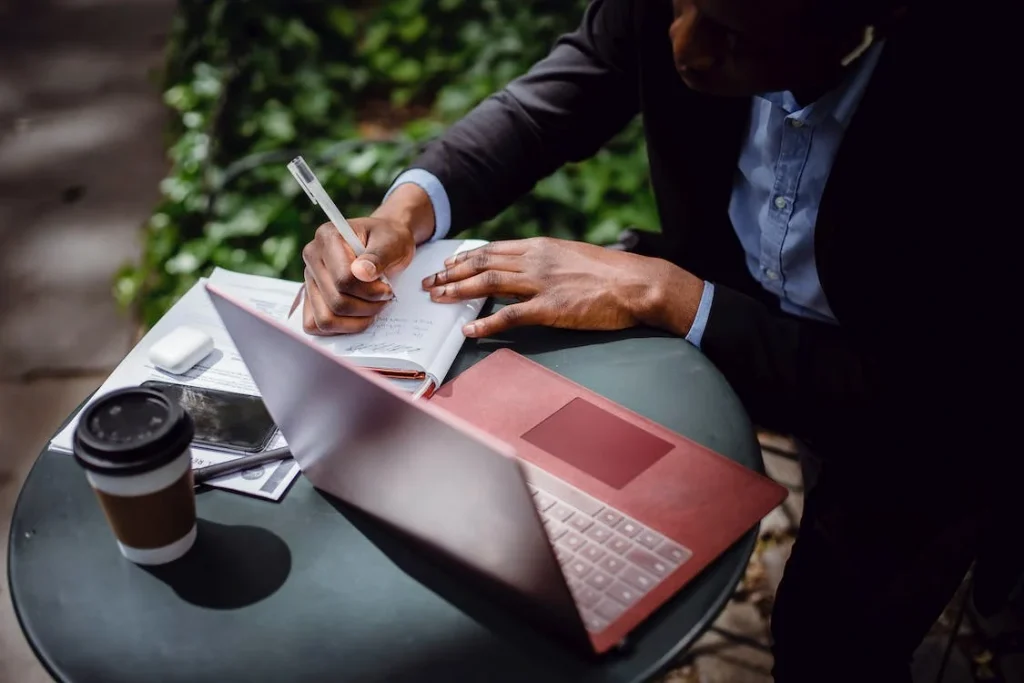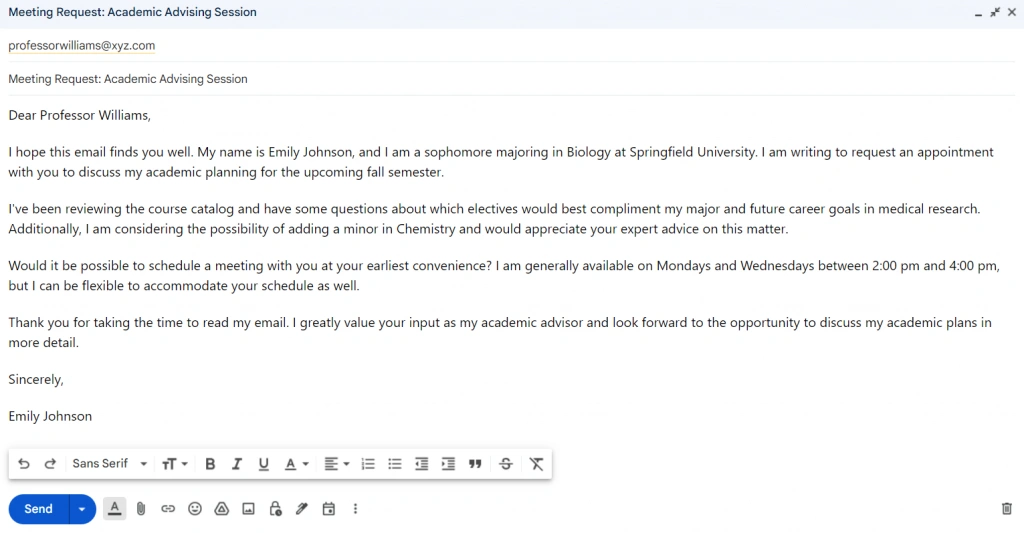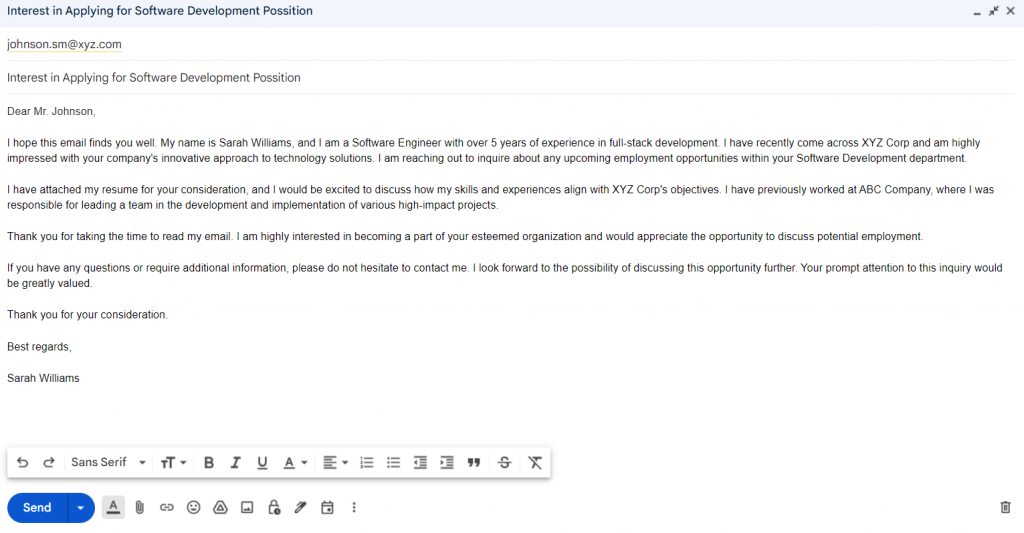Navigating the complexities of formal email writing can often feel overwhelming, especially when reaching out to someone unfamiliar. But the truth is, that knowing how to construct a well-organized, professional email can significantly improve your communication skills and open doors for opportunities. This guide seeks to clarify the components of formal emails, from the subject line down to the signature. By the end of this article, you will have the tools to prepare effective, glossy emails that adhere to professional standards and make every interaction count.
Structure of a formal email
The structure of a formal email is not radically different from an informal one, but it is more polished and follows specific etiquette. A formal email generally includes the following elements:
- A subject line. A brief, appropriate title that summarizes the email’s purpose.
- A formal email greeting. A generous opening that addresses the recipient respectfully.
- Email body text. The main content is structured logically and using formal language.
- A formal email ending. A closing statement that is polite and calls for specific action or response.
- A signature. Your sign-off, which usually includes your full name and often your professional title or contact information.
Integrating these elements with care improves the effectiveness of your formal emails, making them easier to read and more likely to elicit the expected response.

The subject line
The subject line serves as the headline for your email and plays a crucial role in catching the recipient’s attention. Although it may seem like a small detail, its significance should not be underestimated. A clear subject line can greatly increase the likelihood that your email will be opened and receive a timely response.
As a side note, it’s advisable not to enter the recipient’s email address in the designated recipient line—located above the subject line—until you are completely ready to send your email. This helps to prevent accidentally sending an unfinished email. The same warning should be exercised when filling out the Cc and Bcc lines.

The subject line should be both clear and concise, providing a snapshot of the email’s content in just 5-8 words. This not only grabs the recipient’s attention but also encourages timely responses. Always remember to fill in the specified subject line box, which is separate from the email body, to avoid sending an email without a subject.
For example:
- Seeking editor position inquiry. This subject line indicates the sender asks about an editor position, making it relevant to HR or the editorial team.
- The explanation for today’s absence. This subject immediately tells the recipient that the email will discuss an absence, prompting a quicker response from a manager or professor.
- Request for a recommendation letter. This line specifies that the email will be about a letter of recommendation, prompting the recipient to the nature and urgency of the request.
- Inquiry for scholarship application. Clearly stating that the email is about a scholarship application will make it easier for academic or financial offices to prioritize the email.
- This week’s meeting agenda. This subject line quickly informs the team or attendees that the email contains the agenda for an upcoming meeting.
- Urgent: Family emergency today. Using “urgent” and specifics about the emergency make this email a high priority for immediate action.
- Friday’s conference RSVP is needed. This one flags the importance of responding about an upcoming conference, encouraging the recipient to open it quickly.
Each of these examples concisely describes the email’s subject matter to the recipient, aiding them in prioritizing your message for reading. The subject line is the first thing the recipient sees when your email arrives, making it a crucial component for effective communication.

Greeting
Choosing an appropriate formal email greeting is essential for showing respect to the recipient. The greeting you select should match the context and purpose of your email, effectively setting the tone for the ensuing conversation. Here are some commonly used formal email greetings:
- Dear Mr./Mrs./Dr./Professor [Last name],
- Good morning/afternoon [recipient’s name],
- To whom it may concern,
- Greetings,
- Hello [recipient’s name],
Selecting an appropriate greeting is crucial because it sets the initial tone for the rest of your message.
For example:
- If you’re contacting your Uncle Mike for formal matters, an appropriate opener could be, “Dear Uncle Mike…”
- When corresponding with a potential employer regarding job opportunities, a more formal salutation like, “Dear Ms. Smith…” would be fitting.
- If you’re contacting a client named Sarah whom you’ve previously met, you might use, “Good morning, Sarah…”
- When you’re emailing a professional understanding named Alex and want to keep it somewhat informal, “Hello Alex…” would be appropriate.
- If you’re reaching out to a group of people whose names you don’t know, “Greetings” would suffice.
In cases where you don’t know the recipient, “To whom it may concern,” and “Greetings,” serve as just formal greetings. However, it’s always preferable to identify the name of the person you’re emailing and address them directly when possible.
Typically, a comma follows the greeting in your email. However, you can also use a colon in very formal settings. The key point is to make sure your greeting is respectful and suitable for the intended audience. By carefully selecting your email greeting, you not only facilitate easier arrangement with your message but also increase the likelihood of receiving a prompt and relevant response.

Email body text
The main content of an email is referred to as the email body. It usually focuses on a single topic or a set of closely related topics. The first thing you should do in the email body is clarify the reason for your correspondence.
Clarifying the purpose of your email allows the recipient to understand the context, making it easier for them to assist or respond to you. You can introduce the purpose of your email with phrases such as:
- I would like to inquire about…
- I’m writing to express my interest in…
- I’m contacting you regarding…
- I hope to clarify…
- I wish to request…
- I’m interested in learning more about…
- I’d like to confirm details about…
- I’m looking for further information on…
If you’ve never had any interaction with the recipient before, it’s polite to briefly introduce yourself before stating your primary concern.
For example:
- When seeking professional networking opportunities or potential collaborations, proper introduction is key. In the following example, Emily clearly introduces herself and concisely outlines the reason for her email to Dr. Brown, facilitating a more straightforward understanding of her intentions:
| Dear Dr. Brown, I am Emily Williams, a junior research analyst at DEF Corporation. I’ve been following your work in the field of nanotechnology and would like to discuss possible collaborations between our institutions. |
It’s recommended to keep your email concise. Remember, most people prefer to go through their emails quickly, so avoid unnecessary developments.
For example:
- If you’re requesting time off work due to a family emergency, you might simply state, ‘I have a family emergency and need to take the day off,’ rather than going into exhaustive detail about the situation.
For an added touch of professionalism and courtesy, consider starting the email with an expression of gratitude if you are responding to a prior message. Phrases like “I appreciate your timely response,” or “Thanks for getting back to me,” can set a positive tone for the rest of the conversation.

Ending
A formal email’s ending serves as a section to request a specific action and to express gratitude to the person you are emailing. Striking a balance between your request and polite language is generally good practice. This not only shows courtesy but also improves the chances of receiving a positive response. These phrases can be tailored to fit various situations and the specific context of your email. Here are some of them you can use:
- Thank you for your consideration, and I look forward to hearing from you soon.
- If you have any questions or concerns, please do not hesitate to let me know.
- I look forward to the opportunity to work together.
- Thank you for your feedback; it is greatly appreciated.
- Your prompt attention to this matter would be highly valued.
- I am grateful for the time you’ve taken to read my email.
- Should you need any additional information, feel free to contact me.
- I appreciate your understanding and assistance regarding this matter.
- Thank you in advance for your cooperation.
- I am excited about the possibility of collaborating and would be happy to discuss further.
Much like the opening of a formal email sets the tone for the entire conversation, the concluding section also plays a vital role in creating a lasting impression and setting the stage for future interactions.
For example:
- In the context of our example, Emily Williams has proposed a collaboration with Dr. Brown and aims to get a timely response. To achieve this, she specifies a date by which she’d like to hear back, offers to answer any questions, and ends the email with a polite sign-off. In this manner, she creates a structured and polite ending to her formal email, like this:
| I hope we can arrange a meeting in the near future to explore the possibilities for collaboration. Kindly let me know by September 20th if you are available to discuss this further. If you have any questions or require additional information, please do not hesitate to contact me. Thank you for your attention to this matter, and I look forward to the opportunity of working together. Best regards, Emily Williams |
This is an effective formal email ending because Emily Williams clearly articulates her request for possible collaboration, while also expressing appreciation for Dr. Brown’s time to read and potentially respond to her email.
Signature
Just as selecting the right greeting sets the stage for your email, choosing an appropriate formal email signature is equally critical. The signature serves as the closing note, supporting the respectful tone set throughout your message. It also provides a concluding touch that can influence the impression you leave on the recipient.
Some commonly used polite formal email signatures that can be adapted to various situations include:
- Respectfully,
- Sincerely,
- Thanks again,
- Kind regards,
- Yours faithfully,
- Best regards,
- With appreciation,
- Yours truly,
When it comes to formatting your email signature, there are some best practices to follow. Always begin a new paragraph for your signature and another separate paragraph for your name. It’s advisable to sign with both your first and last names in formal communications. If you’re writing on behalf of an organization, the name of the organization should appear below your own name.
By adhering to these guidelines, you can guarantee that your email stays professional and polite from start to finish, thereby increasing the chance of receiving a favorable response.
For example:
| Thank you for your assistance with the project. Your expertise has been invaluable, and I’m looking forward to our continued collaboration. Best wishes, John Smith ABC Enterprises, Project Manager |
His formal signature, ‘Best wishes,’ and including his job title add to the email’s overall professional tone. This sets the stage for continued positive interactions.

Tips for creating a formal email Before You hit send
Great, you’re nearly ready to send your formal email! But hold on—before you click that “Send” button, let’s make sure everything is in order. Ensuring your email is polished, professional, and error-free is crucial. A well-crafted email doesn’t just effectively convey your message; it also sets the tone for future interactions and leaves a lasting impression. Here’s a comprehensive checklist to cover all the bases, from the basics like spelling and grammar to more nuanced elements like tone and timing:
- Proofread. Always check your spelling and grammar before hitting ‘Send.’ To make this process easier and more accurate, consider using our proofreading tool to confirm everything is in order.
- Use a professional email address. Guarantee your email address is attached to a professional format, such as [email protected]. Avoid using informal or inappropriate email addresses like ‘[email protected].’
- Descriptive subject line. Your subject line should provide a good idea of the email’s content, attracting the recipient to open it.
- Check for tone. Keep a professional and respectful tone, especially when discussing sensitive or complex issues.
- Signature block. Include a formal signature block with your full name, title, and contact information for a professional look and easy follow-up.
- Review for attachments. Double-check that all necessary documents are attached, especially if they’re mentioned in the email body.
- Time it right. Consider your email’s timing; avoid sending business emails late at night or over the weekend unless necessary.
- Use bullet points or numbering. For emails with a lot of information or requests, use bullet points or numbered lists for readability.
- Ask for acknowledgment. If the email is important, consider asking for a confirmation of receipt.
- Manage Cc and Bcc. Use Cc for visible additional recipients and Bcc to keep others hidden. Include them if your email involves multiple parties.
- Hyperlinks. Guarantee all hyperlinks are working and lead to the correct websites or online resources.
- Mobile-friendly. Check how your email appears on a mobile device, as many people check their emails on the go.
Once you’ve ticked off these boxes, you’re ready to hit that ‘Send’ button with confidence in your formal email!
Formal email examples
Today, email communication is an essential skill, especially in professional settings. Whether you’re reaching out to an academic advisor or asking about job opportunities, the ability to write a brief, clear, and professionally formatted email can set the stage for a productive relationship. Knowing what to include—and what not—can make all the difference in how your message is received. To assist you in preparing your own emails, below you’ll find brief examples of formal emails that can serve as templates or inspiration for your own correspondence.
- Example 1: Formal email reaching out to an academic advisor.

- Example 2: Formal email inquiring about employment opportunities.

Conclusion
| Mastering the art of formal email writing can open doors to new opportunities and enhance your professional communication skills. This guide has walked you through each crucial component, from a compelling subject line to a courteous signature. Armed with this knowledge, you’re now ready to compose effective, well-structured formal emails that adhere to professional standards. So go ahead and hit that ‘Send’ button with confidence, knowing you’re well-equipped to make every interaction count. |
